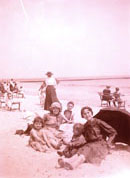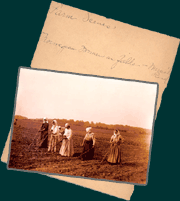
A family enjoying the beach at Coney Island, about 1900.
ID 32.351.292 |

Young girls help earn a living by making hats, Little Italy neighborhood in New York City, about 1900.
ID 32.351.237 |

Boys having a cookout on the beach at Jamaica Bay, Far Rockaway, about 1900.
ID 32.351.108 |

Norwegian immigrant women laboring at their farm work, about 1900.
ID 32.351.397
|
|
Chandler was born Jennie Randolph Young in New Jersey on September 3, 1865 to William Young and Mary Lewis Young. An only child, Jennie was raised by her father and stepmother, Sarah Bennett Young. The family moved to Brooklyn, New York, when Jennie was six, so her father could work as the city editor for the New York Sun newspaper. Jennie followed the normal “career path” for a young lady at that time, marrying William Goodnow Chandler on April 25, 1888. The groom, a neighbor, worked as a sales representative for a picture frame manufacturer. The newlyweds took up residence at 18 Hart Street in Brooklyn, where they welcomed a son, William Young Chandler, on October 12, 1890. But, then, the unexpected happened—Jennie’s husband died that December of typhoid fever, leaving her a young widow with a two-month-old baby. Chandler began to earn a living for herself and her child by taking photographs and writing special feature articles for the New York Herald newspaper. She also wrote and illustrated articles for women’s magazines, beginning to spell her first name “Jenny.”
Jenny Chandler’s photographs have an immediacy—a “you are there” quality. She had a remarkable talent for portraying on film the lives of people of diverse economic and ethnic backgrounds. Chandler captured well-off Brooklyn girls and boys playing games, the exuberance of families enjoying the beach at Coney Island, the well-mannered curiosity of students on a museum visit, young girls bent over their sewing tasks, scruffy boys hanging out at the beach, children gathering tomatoes, a fisherman mending his net, shipwrights making wooden boats, and Norwegian immigrant women laboring at their farm work.
In 1913, Chandler and her 23-year-old son moved to a smaller townhouse in Brooklyn at 265 Washington Avenue. An article Chandler wrote that same year for the November issue of The House Beautiful offers us a rare glimpse into the journalist’s home life. While presenting ideas about the merits of the simpler lines of Colonial-style furnishings to her readers, she wrote:
“Being obliged to convert the room usually selected for this [family dining] purpose into an office for the professional member of the family, and the house not being blessed with an extension, we were denied this boon when we moved into our present home last spring. ‘I fear it’s the basement for ourselves,’ gloomily exclaimed the son of the house, who had his eye on the front ground floor apartment for a billiard-room, when we came to discuss the question of the dining-room…The heavy oak furniture, which had given an air of elegance and style to the oak-paneled and tapestry-covered walls of the suburban house from which we had come, made a caricature of the room.”
In 1922 at the age of 56, Jenny Young Chandler died of a heart ailment, leaving a photographic legacy of over 800 glass plate negatives in her home on Washington Avenue. Ten years later, Betty R. K. Pierce, the subsequent owner of the house, contacted Henry Ford, hoping “to have Mrs. Chandler’s work preserved in some way.” Mrs. Pierce had read about Henry Ford’s museum and historical village, and thought the photographs particularly related to Mr. Ford’s collections: “The negatives of Antiques are from many private collections, andirons, bead bags, furniture, interiors of old houses with their Antique furniture, old wooden Indians, old money, miniatures, ivories, glass, etc, etc. Then there are hundreds of street scenes, shore, dry dock, Prospect Park - Children - Wow!” James A. Humberstone of Henry Ford’s staff immediately answered Mrs. Pierce, stating that these glass negatives were indeed worth preserving. He arranged for the five large boxes to be shipped from New York to Michigan in 1932.
The result of this donation is an amazing document of early 20th century life.
Cynthia Read Miller
Curator, Photography & Prints
|

